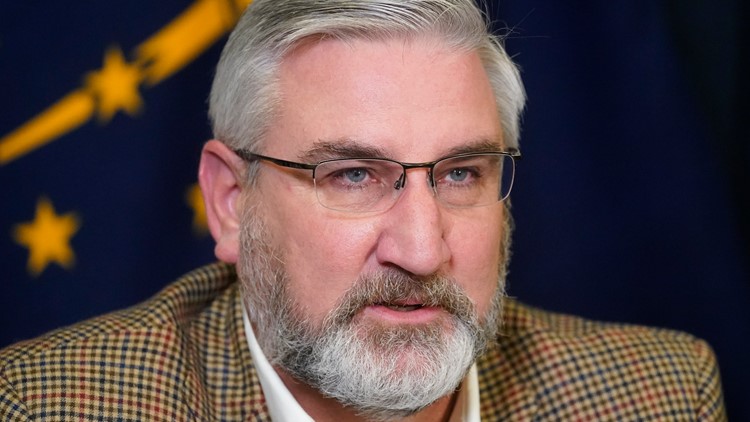INDIANAPOLIS — There’s a reason that President Truman had a sign on his desk reading “The Buck Stops Here” that became ingrained in American culture. There’s a reason that a statue of Gov. Oliver P. Morton along with two Union soldiers guards the east entrance to the Indiana Statehouse.
These reasons all point to one critical thing: Leadership. In the case of Morton and Truman, they rose to power and made crucial and astute decisions during the Civil War and World War II with no playbook. Just like Gov. Eric Holcomb and 49 of his American counterparts did beginning about a year ago with the COVID-19 pandemic.
Holcomb is now faced with an Indiana General Assembly trying to whittle away what little power an Indiana governor has. There are efforts to crimp the governor’s power that he exercised 55 times via executive orders since the pandemic began in March 2020.
Included in this legislation would be exemptions for churches during pandemic shutdown orders. “It’s just at any time during those extensions, the legislative body may say, ‘OK, the third extension we need to come back and at least have a discussion,’” said House Majority Leader Matt Lehman.
Other legislation by State Rep. Bob Morris would prohibit the governor from placing restrictions on any business’s capacity or operating hours. It would block the governor from suspending elective surgeries at hospitals.
A Senate committee unanimously passed Senate Bill 407, which would give a governor a 30-day executive order which he could then extend another 15 days, unless the General Assembly has convened or he calls a special session. This would allow legislators to pass bills authorizing the order. “What we’re trying to do with this bill is broaden the number of people who are involved in the decision-making process,” State Sen. Susan Glick told the Indianapolis Business Journal. “I think all of us, both minority and majority members, felt left out.”
Holcomb has been operating under I.C. 10-14-3-12, or the “Disaster emergencies; emergency gubernatorial powers” law, that was passed in 2010. The governor can declare a disaster emergency by executive order or proclamation “if the governor determines that a disaster has occurred or that the occurrence or threat of a disaster is imminent.” The statute allows the governor to renew executive orders every 30 days.
He or she can commandeer private property, move state employees, order the evacuation of endangered areas, control the “ingress and egress” to such areas, suspend or limit the sale and transportation of alcoholic beverages, explosives or combustibles, provide emergency housing, allow out-state licensed personnel to operate in the state, and give specific authority to allocate drugs, foodstuffs, and other essential materials and services.
To put these bills into context, it’s important to understand what leaders like Gov. Holcomb were facing a little more than a year ago. When COVID-19 caught the attention of U.S. officials, there were so many unknowns: How did it spread? Who was susceptible? How lethal was it? Would it impact children and adults or the elderly differently? Could it be spread in school classrooms?
Holcomb, other governors and President Trump operated with a number of blind spots and came to the unprecedented decision in mid-March to shut the economy down. It wasn’t until early April that the consensus developed that COVID-19 was spread by aerosol particles. Health officials ranging from U.S. Surgeon General Jerome Adams and Indiana Health Commissioner Kristina Box were advising against face-masking then (though in Adams’s case, it was to preserve the limited availability of N-95 masks for frontline health professionals).
By the end of April, the shifting consensus (with the notable exception of Rep. Morris) was that face-masking was the best step prior to vaccine at preventing the contagion spread.
In the midst of the pandemic crisis, it wasn’t up to a legislative committee to make the tough decisions. It was up to the president and the governor. The buck would stop with them. Since then, there was an election in which Holcomb was returned for a second term with a landslide, and Trump was ousted by a more than a 7 million-vote plurality.
Now let’s go to the “what ifs.” Like ... what if the next pandemic might be more severe than COVID-19? What if the next pandemic is far more lethal for children? Or is far more transmissible? Preventing the governor from shutting down schools or churches in the wake of a pandemic would severely limit the executive response, potentially creating a more arduous crisis.
Evansville attorney Joshua Claybourn observed in January: “By separating powers among branches, the Founders sought to safeguard against tyranny. We need separation of powers and checks and balances not merely in spite of emergencies, but often because of them.” He advocates revise emergency power laws that incorporate more checks and balances while maintaining flexibility.
The fact that there were few calls for a General Assembly special session during the first nine months of the pandemic means that Gov. Holcomb and staff were in what he calls “constant” contact with legislative leadership.
More checks and balances are fine. But anything that would crimp a future governor’s flexibility by creating prohibitions that could hinder the state’s response in dealing with a wicked curve ball could have disastrous impacts down the road.
The buck should stop with the governor.
The columnist is publisher of Howey Politics Indiana at www.howeypolitics.com. Find Howey on Facebook and Twitter @hwypol.



